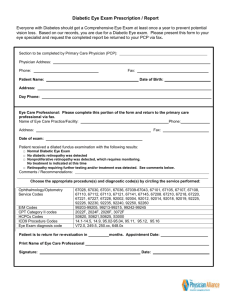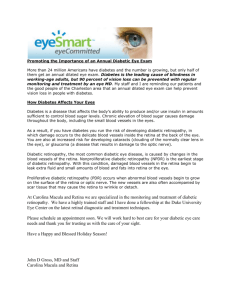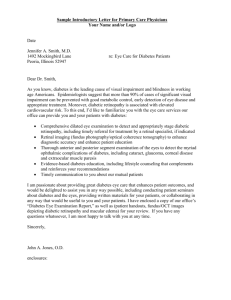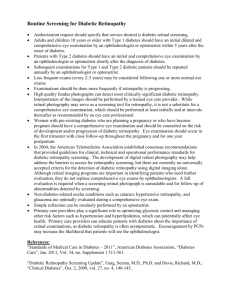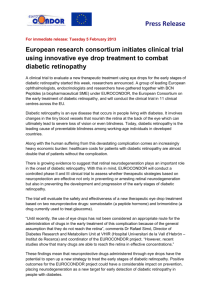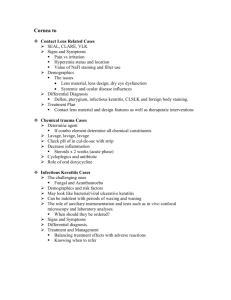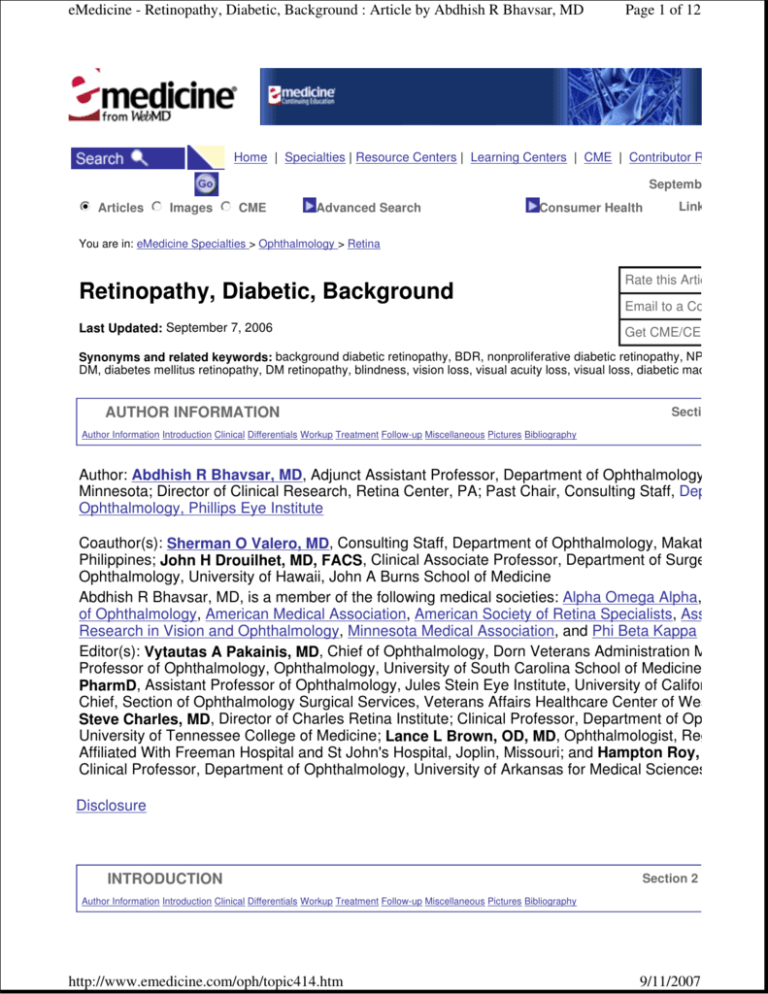
eMedicine - Retinopathy, Diabetic, Background : Article by Abdhish R Bhavsar, MD
Page 1 of 12
Home | Specialties | Resource Centers | Learning Centers | CME | Contributor Recruitment
September 11, 2007
i Articles n
j
k
l
m
n
j Images n
k
l
m
j CME
k
l
m
Advanced Search
Consumer Health
Link to this site
You are in: eMedicine Specialties > Ophthalmology > Retina
Retinopathy, Diabetic, Background
Last Updated: September 7, 2006
Rate this Article
Email to a Colleague
Get CME/CE for article
Synonyms and related keywords: background diabetic retinopathy, BDR, nonproliferative diabetic retinopathy, NPDR, diabetes
DM, diabetes mellitus retinopathy, DM retinopathy, blindness, vision loss, visual acuity loss, visual loss, diabetic macular edema,
AUTHOR INFORMATION
Section 1 of 10
Author Information Introduction Clinical Differentials Workup Treatment Follow-up Miscellaneous Pictures Bibliography
Author: Abdhish R Bhavsar, MD, Adjunct Assistant Professor, Department of Ophthalmology, Universit
Minnesota; Director of Clinical Research, Retina Center, PA; Past Chair, Consulting Staff, Department o
Ophthalmology, Phillips Eye Institute
Coauthor(s): Sherman O Valero, MD, Consulting Staff, Department of Ophthalmology, Makati Medical C
Philippines; John H Drouilhet, MD, FACS, Clinical Associate Professor, Department of Surgery, Sectio
Ophthalmology, University of Hawaii, John A Burns School of Medicine
Abdhish R Bhavsar, MD, is a member of the following medical societies: Alpha Omega Alpha,
of Ophthalmology, American Medical Association, American Society of Retina Specialists, Association fo
Research in Vision and Ophthalmology, Minnesota Medical Association, and Phi Beta Kappa
Editor(s): Vytautas A Pakainis, MD, Chief of Ophthalmology, Dorn Veterans Administration Medical Ce
Professor of Ophthalmology, Ophthalmology, University of South Carolina School of Medicine;
PharmD, Assistant Professor of Ophthalmology, Jules Stein Eye Institute, University of California at Los
Chief, Section of Ophthalmology Surgical Services, Veterans Affairs Healthcare Center of West Los Ang
Steve Charles, MD, Director of Charles Retina Institute; Clinical Professor, Department of Ophthalmolog
University of Tennessee College of Medicine; Lance L Brown, OD, MD, Ophthalmologist, Regional Eye
Affiliated With Freeman Hospital and St John's Hospital, Joplin, Missouri; and Hampton Roy, Sr, MD
Clinical Professor, Department of Ophthalmology, University of Arkansas for Medical Sciences
Disclosure
INTRODUCTION
Section 2 of 10
Author Information Introduction Clinical Differentials Workup Treatment Follow-up Miscellaneous Pictures Bibliography
http://www.emedicine.com/oph/topic414.htm
9/11/2007
eMedicine - Retinopathy, Diabetic, Background : Article by Abdhish R Bhavsar, MD
Page 2 of 12
Background: Diabetes mellitus (DM) is a major medical problem throughout the world. Diabetes causes
long-term systemic complications, which have considerable impact on both the patient and the society be
typically affects individuals in their most productive years. Ophthalmic complications of diabetes include c
abnormalities, glaucoma, iris neovascularization, cataracts, and neuropathies. However, the most comm
potentially most blinding of these complications is diabetic retinopathy.
Pathophysiology: The exact mechanism by which diabetes causes retinopathy remains unclear, but se
theories have been postulated to explain the typical course and history of the disease.
Growth hormone
Growth hormone appears to play a causative role in the development and progression of diabetic retinop
noted that diabetic retinopathy was reversed in women who had postpartum hemorrhagic necrosis of the
gland (Sheehan syndrome). This led to the controversial practice of pituitary ablation to treat or prevent d
retinopathy in the 1950s. This technique has been abandoned because of numerous systemic complicat
the discovery of the effectiveness of laser treatment.
Platelets and blood viscosity
The variety of hematologic abnormalities seen in diabetes, such as increased erythrocyte aggregation, d
RBC deformability, increased platelet aggregation, and adhesion, predispose to sluggish circulation, end
damage, and focal capillary occlusion. This leads to retinal ischemia, which, in turn, contributes to the de
of diabetic retinopathy.
Aldose reductase and vasoproliferative factors
Fundamentally, DM causes abnormal glucose metabolism as a result of decreased levels or activity of in
Increased levels of blood glucose are thought to have a structural and physiologic effect on retinal capilla
causing them to be both functionally and anatomically incompetent.
A persistent increase in blood glucose levels shunts excess glucose into the aldose reductase pathway i
tissues, which converts sugars into alcohol (eg, glucose into sorbitol, galactose to dulcitol). Intramural pe
retinal capillaries seem to be affected by this increased level of sorbitol, eventually leading to the loss of
function (ie, autoregulation of retinal capillaries).
Loss of function of pericytes results in weakness and eventual saccular outpouching of capillary walls. Th
microaneurysms are the earliest detectable signs of DM retinopathy.
Ruptured microaneurysms (MA) result in retinal hemorrhages either superficially (flame-shaped hemorrh
deeper layers of the retina (blot and dot hemorrhages).
Increased permeability of these vessels results in leakage of fluid and proteinaceous material, which clin
appears as retinal thickening and exudates. If the swelling and exudation would happen to involve the m
diminution in central vision may be experienced. Macular edema is the most common cause of vision los
patients with nonproliferative diabetic retinopathy (NPDR). However, it is not exclusively seen only in pat
NPDR, but it also may complicate cases of proliferative diabetic retinopathy (PDR).
Another theory to explain the development of macular edema deals with the increased levels of diacylgly
(DAG) from the shunting of excess glucose. This is thought to activate protein kinase C (PKC), which, in
http://www.emedicine.com/oph/topic414.htm
9/11/2007
eMedicine - Retinopathy, Diabetic, Background : Article by Abdhish R Bhavsar, MD
Page 3 of 12
affects retinal blood dynamics, especially permeability and flow, leading to fluid leakage and retinal thicke
As the disease progresses, eventual closure of the retinal capillaries occurs, leading to hypoxia. Infarctio
nerve fiber layer leads to the formation of cotton-wool spots (CWS) with associated stasis in axoplasmic
More extensive retinal hypoxia triggers compensatory mechanisms within the eye to provide enough oxy
tissues. Venous caliber abnormalities, such as venous beading, loops, and dilation, signify increasing hy
almost always are seen bordering the areas of capillary nonperfusion. Intraretinal microvascular abnorma
(IRMA) represent either new vessel growth or remodeling of preexisting vessels through endothelial cell
within the retinal tissues to act as shunts through areas of nonperfusion.
Further increases in retinal ischemia trigger the production of vasoproliferative factors that stimulate new
formation. The extracellular matrix is broken down first by proteases, and new vessels arising mainly from
venules penetrate the internal limiting membrane and form capillary networks between the inner surface
retina and the posterior hyaloid face.
Neovascularization most commonly is observed at the borders of perfused and nonperfused retina and m
commonly occur along the vascular arcades and at the optic nerve head. The new vessels break through
along the surface of the retina and into the scaffold of the posterior hyaloid face. By themselves, these ve
rarely cause visual compromise. However, they are fragile and highly permeable. These delicate vessels
disrupted easily by vitreous traction, which leads to hemorrhage into the vitreous cavity or the preretinal s
These new blood vessels initially are associated with a small amount of fibroglial tissue formation. Howe
density of the neovascular frond increases, so does the degree of fibrous tissue formation. In later stages
vessels may regress leaving only networks of avascular fibrous tissue adherent to both the retina and the
hyaloid face. As the vitreous contracts, it may exert tractional forces on the retina via these fibroglial conn
Traction may cause retinal edema, retinal heterotropia, and both tractional retinal detachments and retina
formation with subsequent detachment.
Frequency:
In the US: Approximately 16 million Americans have diabetes, with 50% of them not even aware th
have it. Of those that know, only one half receives appropriate eye care. Thus, it is not surprising th
retinopathy is the leading cause of new blindness in persons aged 25-74 years in the United States
responsible for more than 8000 cases of new blindness each year. This means that diabetes is res
12% of blindness; the rate is even higher among certain ethnic groups.
Internationally: The incidence of diabetes appears to be increasing throughout the world, at least
to the increasing incidence of obesity and sedentary lifestyle. Dietary changes involving diets with h
and carbohydrate intake as well as the increasing size of portions of food and drinks over the past
decades may also be responsible.
Mortality/Morbidity: The treatment of diabetic retinopathy entails tremendous costs, but it has been esti
this represents only one eighth of the costs of social security payments for vision loss. This cost does no
to the cost in terms of loss of productivity and quality of life.
Race: An increased risk of diabetic retinopathy appears to exist in patients with Native American, Hispan
African American heritage.
http://www.emedicine.com/oph/topic414.htm
9/11/2007
eMedicine - Retinopathy, Diabetic, Background : Article by Abdhish R Bhavsar, MD
Page 4 of 12
CLINICAL
Section 3 of 10
Author Information Introduction Clinical Differentials Workup Treatment Follow-up Miscellaneous Pictures Bibliography
History: In the initial stages, patients are generally asymptomatic; however, in the more advanced stage
disease, patients may experience symptoms, including blurred vision, distortion, or visual acuity loss.
Physical:
Microaneurysms
Earliest clinical sign of diabetic retinopathy
Secondary to capillary wall outpouching due to pericyte loss
Appear as small red dots in the superficial retinal layers
Fibrin and RBC accumulation in the microaneurysm lumen
Rupture produces blot/flame hemorrhages
May appear yellowish in time as endothelial cells proliferate and produce basement membran
Dot and blot hemorrhages
Occur as microaneurysms rupture in the deeper layers of the retina such as the inner nuclear
plexiform layers
Appear similar to microaneurysms if they are small; may need fluorescein angiography to dist
between the two
Flame-shaped hemorrhages - Splinter hemorrhages that occur in the more superficial nerve fiber la
Retinal edema and hard exudates - Caused by the breakdown of the blood-retina barrier, allowing
serum proteins, lipids, and protein from the vessels
Cotton-wool spots
Nerve fiber layer infarction from occlusion of precapillary arterioles
Fluorescein angiography - No capillary perfusion
Frequently bordered by microaneurysms and vascular hyperpermeability
Venous loops, venous beading
Frequently adjacent to areas of nonperfusion
http://www.emedicine.com/oph/topic414.htm
9/11/2007
eMedicine - Retinopathy, Diabetic, Background : Article by Abdhish R Bhavsar, MD
Reflects increasing retinal ischemia
Most significant predictor of progression to PDR
Page 5 of 12
Intraretinal microvascular abnormalities
Remodeled capillary beds without proliferative changes
Collateral vessels that do not leak on fluorescein angiography
Usually can be found on the borders of the nonperfused retina
Macular edema
This condition is the leading cause of visual impairment in patients with diabetes. A reported 7
cases of macular edema are diagnosed annually.
Possibly due to functional damage and necrosis of retinal capillaries
Clinically significant macular edema (CSME) is defined as any of the following:
Retinal thickening located 500 µm or less from the center of the foveal avascular zone (
Hard exudates with retinal thickening 500 µm or less from the center of the FAZ
Retinal thickening 1 disc area or larger in size located within 1 disc diameter of the FAZ
Mild nonproliferative diabetic retinopathy - Presence of at least 1 microaneurysm
Moderate nonproliferative diabetic retinopathy
Presence of hemorrhages, microaneurysms, and hard exudates
Soft exudates, venous beading, and IRMA less than that of severe NPDR
Severe nonproliferative diabetic retinopathy (4-2-1)
Hemorrhages and microaneurysms in 4 quadrants
Venous beading in at least 2 quadrants
IRMA in at least 1 quadrant
Mild NPDR reflects structural changes in the retina caused by the physiological and anatomical effe
diabetes. On the other hand, the more advanced stages of NPDR reflect the increasing retinal isch
setting up the stage for proliferative changes.
Causes: Risk factors
http://www.emedicine.com/oph/topic414.htm
9/11/2007
eMedicine - Retinopathy, Diabetic, Background : Article by Abdhish R Bhavsar, MD
Duration of the diabetes
In patients with type I diabetes, no clinically significant retinopathy can be seen in the first 5 y
the initial diagnosis of diabetes is made. After 10-15 years, 25-50% of patients show some sig
retinopathy. This prevalence increases to 75-95% after 15 years and approaches 100% after
diabetes.
In patients with type II diabetes, the incidence of diabetic retinopathy increases with the durat
disease. Of patients with type II diabetes, 23% have NPDR after 11-13 years, 41% have NPD
16 years, and 60% have NPDR after 16 years.
Glucose control
Page 6 of 12
The Diabetic Complications Control Trial (DCCT) has demonstrated that intensive glucose co
reduced the incidence and the progression of diabetic retinopathy in patients with insulin
diabetes mellitus (IDDM).
Although no similar trials for patients with non–insulin–dependent diabetes mellitus (NIDDM)
completed, the American Diabetes Association (ADA) has suggested that glycosylated hemo
levels of less than 7% (reflecting long-term glucose levels) should be the goal in all patients to
slow down the onset of diabetes-related complications.
Renal disease, as evidenced by proteinuria and elevated BUN/creatinine levels, is an excellent pre
presence of retinopathy. This probably is due to the fact that both conditions are caused by DM
microangiopathies such that the presence and severity of one reflects that of the other. Evidence s
that aggressive treatment of the nephropathy may have a beneficial effect on the progression of dia
retinopathy and neovascular glaucoma.
Systemic hypertension, in the setting of diabetic nephropathy, correlates well with the presence of r
Independently, hypertension also may complicate diabetes in that it may result in hypertensive retin
changes superimposed on the preexisting diabetic retinopathy, further compromising retinal blood f
Proper management of hyperlipidemia (elevated serum lipids) may result in less retinal vessel leak
hard exudate formation. The reason behind this is unclear.
Pregnant women without any diabetic retinopathy run a 10% risk of developing NPDR during their p
Of those with preexisting NPDR, 4% progress to the proliferative type.
DIFFERENTIALS
Section 4 of 10
Author Information Introduction Clinical Differentials Workup Treatment Follow-up Miscellaneous Pictures Bibliography
Branch Retinal Vein Occlusion
Central Retinal Vein Occlusion
Ocular Ischemic Syndrome
Retinopathy, Hemoglobinopathies
Sickle Cell Disease
http://www.emedicine.com/oph/topic414.htm
9/11/2007
eMedicine - Retinopathy, Diabetic, Background : Article by Abdhish R Bhavsar, MD
Page 7 of 12
Other Problems to be Considered:
Retinopathy, radiation
WORKUP
Author Information Introduction Clinical Differentials Workup Treatment Follow-up Miscellaneous Pictures Bibliography
Lab Studies:
Fasting glucose and hemoglobin A1c (HbA1c) are important laboratory tests that are perf
HbA1c level is also important in the long-term follow-up care of patients with diabetes and
and maintaining the HbA1c level in the 6-7% range are the goals in the optimal managem
the levels are maintained, then the progression of diabetic retinopathy is reduced substantially, acc
Imaging Studies:
Fluorescein angiography is an invaluable adjunct in the diagnosis and management of diabetic retin
Microaneurysms would appear as pinpoint hyperfluorescence that does not enlarge
test.
Blot and dot hemorrhages can be distinguished from microaneurysms because they
hyperfluorescent.
Areas of nonperfusion appear as homogenous dark patches bordered by occluded blood ves
IRMA is evidenced by collateral vessels that do not leak, usually found in the borders of the n
http://www.emedicine.com/oph/topic414.htm
9/11/2007
eMedicine - Retinopathy, Diabetic, Background : Article by Abdhish R Bhavsar, MD
Page 8 of 12
TREATMENT
Author Information Introduction Clinical Differentials Workup Treatment Follow-up Miscellaneous Pictures Bibliography
Medical Care:
Glucose control: The DCCT has found that intensive glucose control in patients with IDDM has dec
progression of diabetic retinopathy. Although no similar clinical trials for patients with NID
the same principles also apply. In fact, the ADA has suggested that all diabetics (NIDDM and IDDM
glycosylated hemoglobin levels of less than 7% to prevent or at the very least to minimize the long
including DM retinopathy.
The Early Treatment for Diabetic Retinopathy Study (ETDRS) found that 650 mg of aspirin daily did
preventing the progression of DM retinopathy. Additionally, aspirin was not observed to influence th
hemorrhage in patients who required it for cardiovascular disease (CVD) or other conditions.
Surgical Care: The advent of laser photocoagulation in the 1960s and early 1970s provided a
relatively low complication rate and a significant degree of success. This involves directing a high
a coagulative response in the target tissue. In NPDR, laser treatment is indicated in the treatme
macular edema depends on the type and extent of vessel leakage.
If the edema is due to leakage of specific microaneurysms, the leaking vessels are treate
In cases where the foci of leakage are nonspecific, a grid pattern of laser burns is applied. Medium
placed 1 burn size apart covering the affected area.
http://www.emedicine.com/oph/topic414.htm
9/11/2007
eMedicine - Retinopathy, Diabetic, Background : Article by Abdhish R Bhavsar, MD
Page 9 of 12
Other off-label potential treatments of diabetic macular edema (DME) include intravitreal
bevacizumab (Avastin). Both of these medications can result in a substantial reduction or resolution
FOLLOW-UP
Author Information Introduction Clinical Differentials Workup Treatment Follow-up Miscellaneous Pictures Bibliography
Further Outpatient Care:
The frequency of follow-up care is dictated primarily on the baseline stage of the retinopa
Only 5% of patients with mild NPDR would progress to PDR in 1 year and, thus, could be mo
As many as 27% of patients with moderated NPDR would progress to PDR in 1 yea
months.
More than 50% of patients with severe NPDR (preproliferative stage) would progress to PDR
frequent as 2-4 months is mandated to ensure prompt recognition and treatment.
Any stage associated with CSME should be treated and observed closely (every 2-
Complications:
The complications of focal and grid laser therapy include the following:
Decreased central vision
Paracentral scotomas
Choroidal neovascularization
Epiretinal membrane formation
Further increase in macular edema
Prognosis:
The ETDRS has found that laser surgery for macular edema reduces the incidence of mo
or roughly a 2-line visual loss) from 30% to 15% over a 3-year period.
Favorable prognostic factors
Circinate exudates of recent onset
Well-defined leakage
Good perifoveal perfusion
http://www.emedicine.com/oph/topic414.htm
9/11/2007
eMedicine - Retinopathy, Diabetic, Background : Article by Abdhish R Bhavsar, MD
Page 10 of 12
Unfavorable prognostic factors
Diffuse edema/multiple leaks
Lipid deposition in the fovea
Macular ischemia
Cystoid macular edema
Preoperative vision of less than 20/200
Hypertension
Patient Education:
One of the most important aspects in the management of diabetic retinopathy is patient e
integral role in their own eye care. Emphasize the following facts:
Excellent glucose control is beneficial in any stage of diabetic retinopathy. It delays
of the diabetic complications in the eye.
Other systemic problems, such as hypertension, renal disease, and hyperlipidemia,
retinopathy and should be addressed promptly.
Smoking, although not directly proven to affect the course of the retinopathy, may p
delivery to the retina. Therefore, all efforts should be made in the reduction, if not outright ces
Visual symptoms (eg, changes in vision, redness, pain) could be manifestations of disease pr
reported immediately.
DM in general and diabetic retinopathy in particular are progressive conditions such that regu
physician is crucial to detect any changes that may benefit from treatment.
For excellent patient education resources, see eMedicine's Diabetes Center. Also, visit eMedicine's
Diabetic Eye Disease.
MISCELLANEOUS
Author Information Introduction Clinical Differentials Workup Treatment Follow-up Miscellaneous Pictures Bibliography
Medical/Legal Pitfalls:
Failure to emphasize to the patient that focal or grid laser treatment of CSME is not aimed
the risk of moderate visual loss.
PICTURES
Author Information Introduction Clinical Differentials Workup Treatment Follow-up Miscellaneous Pictures Bibliography
http://www.emedicine.com/oph/topic414.htm
9/11/2007
eMedicine - Retinopathy, Diabetic, Background : Article by Abdhish R Bhavsar, MD
Page 11 of 12
Caption: Picture 1. Fundus photograph of early background diabetic retinopathy
showing multiple microaneurysms.
View Full Size Image
eMedicine Zoom View
(Interactive!)
Picture Type: Photo
Caption: Picture 2. Retinal findings in background diabetic retinopathy, including
blot hemorrhages (arrowhead), microaneurysms (short arrow), and hard exudates
(long arrow).
View Full Size Image
eMedicine Zoom View
(Interactive!)
Picture Type: Photo
Caption: Picture 3. Fluorescein angiogram demonstrating an area of capillary
nonperfusion (arrow).
View Full Size Image
eMedicine Zoom View
(Interactive!)
Picture Type: Photo
Caption: Picture 4. Fluorescein angiogram demonstrating foveal dye leakage
caused by macular edema.
View Full Size Image
eMedicine Zoom View
(Interactive!)
http://www.emedicine.com/oph/topic414.htm
9/11/2007
eMedicine - Retinopathy, Diabetic, Background : Article by Abdhish R Bhavsar, MD
Page 12 of 12
Picture Type: Photo
Caption: Picture 5. Fundus photograph of clinically significant macular edema
demonstrating retinal exudates within the fovea.
View Full Size Image
eMedicine Zoom View
(Interactive!)
Picture Type: Photo
BIBLIOGRAPHY
Author Information Introduction Clinical Differentials Workup Treatment Follow-up Miscellaneous Pictures Bibliography
Aiello LM, Cavallerano JD, Aiello LP, Bursell SE: Diabetic retinopathy. In: Guyer DR, Yannuzzi LA,
Vitreous Macula. Vol 2. 1999: 316-44.
Akduman L, Olk RJ: The early treatment for diabetic retinopathy study. In: Kertes C, ed. Clinical Tri
Summary and Practice Guide. 1998: 15-36.
Benson WE, Tasman W, Duane TD: Diabetes mellitus and the eye. Duane's Clinical Ophthalmolog
Bhavsar AR: Diabetic retinopathy: the latest in current management. Retina 2006; 26 (6 Suppl): S7
Federman JL, Gouras P, Schubert H, et al: Systemic diseases. In: Podos SM, Yanoff M, eds. Retin
Ophthalmology. Vol 9. 1994: 7-24.
Frank RN: Etiologic mechanisms in diabetic retinopathy. In: Ryan SJ, ed. Retina. Vol 2. 1994: 1243
Klein R: The Diabetes Control and Complications Trial. In: Kertes C, ed. Clinical Trials in Ophthalm
Guide. 1998: 49-70.
NOTE:
Medicine is a constantly changing science and not all therapies are clearly established. New research changes drug and treatment therapies daily. Th
efforts to provide information that is up-to-date and accurate and is generally accepted within medical standards at the time of publication. However, a
always possible, the authors, editors, and publisher or any other party involved with the publication of this article do not warrant the information in this article is accura
omissions or errors in the article or for the results of using this information. The reader should confirm the information in this article from other sources prior to use. In
contraindications should be confirmed in the package insert. FULL DISCLAIMER
Retinopathy, Diabetic, Background excerpt
About Us | Privacy | Terms of Use | Contact Us | Advertising | Institutional Subscribers
We subscribe to the
HONcode principles of the
Health On the Net Foundation
http://www.emedicine.com/oph/topic414.htm
© 1996-2006 by WebMD
All Rights Reserved
9/11/2007


